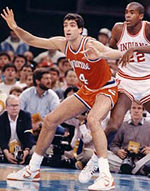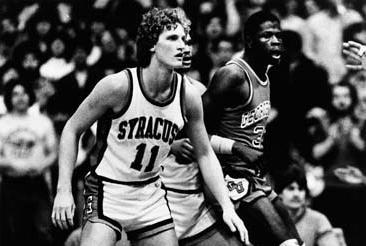Twenty five international players have played basketball for
the Syracuse Orange. Clinton Goodwin, a 5’8”
guard born to American missionaries in Calcutta was the first in line. Chino Obokoh, a reserve center for the Orange
last season, is the latest in the line of international players.
 |
| Rony Seikaly |
Rony Seikaly is probably the greatest international player
for the Orange. The 6’10” center helped
power the Orangemen to the championship game in 1987. He was an outstanding shot blocker and
rebounder, and by his senior year had developed into a strong offensive threat.
Two early All-Americans for the Orangemen were born
overseas. John Barsha was born in Russia, while Joe Schwarzer was born in
Austro-Hungary. The two partnered to
lead the Orangemen to the 1918 National Championship (as voted by the Helms
Foundation). Schwarzer was a 5’11”
center, considered the best center in the East, and Barsha was an outstanding
defensive guard. Due to the evolution of
the game, both would probably be too small for today’s game, but they were
outstanding athletes in their own era.
If I were to create an All-International team for the
Orange, I would start with Seikaly at center. That’s probably the easiest
selection to make.
The team wouldn’t have a true power forward, but I would put
Montreal’s Kris Joseph in that position.
Joseph was very adept at driving to the hoop, and liked playing near the
basket. He would be undersized, but speedy.
 |
| Leo Rautins |
Toronto’s Leo Rautins would be an excellent small forward. Rautins was a triple-double threat, a gifted
passer who preferred to play away from the basket, and would be a good fit at
the three position.
Freshman phenom Tyler Ennis would be my starting point
guard. He would ensure we have a
controlled offense, and would keep the turnovers to a minus. With Ennis and
Rautins both on the court, there would be lots of opportunities for low post
passes to Seikaly and Joseph.
The shooting guard position is the toughest spot to
fill. It comes down to sharp shooting
Marius Janulis versus the versatile Kueth Duany. Janulis was a sniper on the perimeter, and a
great free throw shooter. He was not a strong defender, and was merely adequate
handling the ball, but he sure could shoot.
Duany was a very good three point shooter; not in the same class a
Janulis, but he could make the open three when defenses focused on other
players on the court. Duany’s benefit to
the team is that he was long armed, and played very good zone defense, along
with being a decent rebounder and ball handler.
I would likely choose to start Duany, and have Janulis come off the
bench. Duany could of course also rotate to small forward. Both played in the national championship game with Duany getting the edge with the championship win.
Fab Melo would be my top reserve center, and he would be a
solid defensive replacement to spell Seikaly. There would be an offensive
letdown with Melo on the court, but Melo was a good passer, and the team would
not be hurt having him on the defensive end.
My eighth player would be Donte’ Greene. Greene was a 6’11” three point shooting power
forward. I wasn’t always crazy about his game particularly because he tended to
care more about what was in his best interest as opposed to the team, but
having a tall gifted athlete come off the bench who could hit the long ball is
an invaluable asset on the team.
My ninth player would be Baye Moussa Keita, who would
provide some much needed energy off the bench to back up Seikaly, and to
replace Melo if Melo was indifferent that night. Keita was very limited
offensively, but he could play inspired defense, and get key rebounds.
The tenth, and final, player on my team would be Tom
Huggins. Huggins was a forward for the
Orangemen in the early 1950s. Huggins
was a mature player having been a veteran of World War II; he would be 28 when
he graduated from Syracuse. Huggins was
a solid rebounder and a tenacious defender, and his maturity would help with
some of the younger guys.
Finally, the coach would be Marc Guley. Guley was born in
Czechoslovakia, and coached the Orangemen from 1950-1962. Guley’s career started out well as a coach,
leading the Orangemen to the National Campus Championship in 1951, and to their
first NCAA bid in 1957. The team would
also hit rock bottom after a steady decline in Guley’s last few years. However, as the Orangemen have had no other head
coaches born overseas, the job is his by default.
So we’re looking at a starting five, with really an eight
man rotation, as follows:
- PG-Tyler Ennis,
- SG-Kueth Duany,
- SF-Leo Rautins,
- PF-Kris Joseph
- C-Rony Seikaly.
- Bench: G-Marius Janulis, F-Donte’ Greene and C-Fab Melo
That team would be an NCAA bound team in this era, and
possibly an elite eight team, and with some luck a Final Four. A strong power forward on the team would make me more confident. The team could definitely play big with Rautins taking over the point for periods of time, Duany at the shooting guard, Greene and Joseph up front, and Seikaly down low (or put Seikaly at forward, Melo at center, and drop Joseph).



